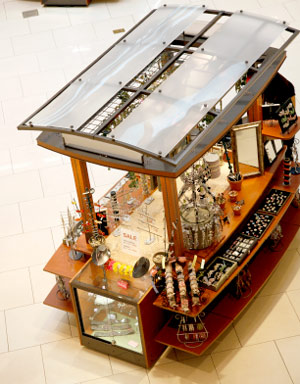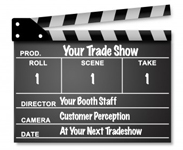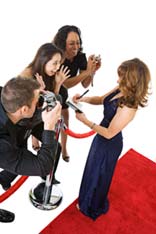How to Attract Your Ideal Visitor to Your Tradeshow Display
Attracting the ideal visitor to your trade show displays begins well before the day of the show. With a few proactive initiatives and show-day follow-up, you can leave less of your booth attendance to staff and start attracting potential customers.
Preshow Marketing
 Preshow marketing can be an effective way of driving interest in your company. Many trade shows today have Twitter hashtags, for example, to which you can refer when making Tweets about your upcoming trade show displays.
Preshow marketing can be an effective way of driving interest in your company. Many trade shows today have Twitter hashtags, for example, to which you can refer when making Tweets about your upcoming trade show displays.
Starting conversations on social media sites or joining existing ones in anticipation of the show can help you isolate potential visitors and learn something about them and their interests before show time. At the show, you’ll match a face with the name and, because of your previous discussions, will be more likely to earn a visit.
Game Day Face-Time
Remember, your trade show displays’ best asset is the face-to-face sales time you have with potential clients. Once you’ve attracted your ideal visitor you don’t want to lose them too quickly to another booth or distraction. Do some research and know as much about your ideal visitor as possible. Study the show program and know what education sessions will be popular. Be aware of keynote speakers so that you can initiate a timely and interesting conversation with prospects.
Other staff tips for engaging and retaining visitors:
- Have a few introductory questions prepared that cannot be answered with yes or no.
- Remember that each visitor is important and should be treated as such. If, for whatever reason, a discussion has to be cut short, offer to follow up and do so.
- Standing staffers are better than seated ones. Standing allows for more engagement and mobility while generally showing more interest in your visitors unless, of course, they can pull up a seat next to you.
- Breathe and stay relaxed.
- Smile. (Let’s hope you don’t have to teach your team this technique.)
Do you need help with your trade show strategy? Let’s Talk.
Vacuuming Is Not Something to Overlook at Your Trade Show
It is no secret that exhibiting at trade shows, while widely considered the best dollar-for-dollar marketing investment, are chock full of costs. When it comes to saving money at shows, the devil is certainly in the details. Sometimes you can grossly over pay for services you might not think about until you even get to the show.
 When exhibiting, people are going to be coming and going in and out of your booth all day for as many days as you are exhibiting. If you have carpet, you are probably going to need to think about vacuuming if you want to keep your booth presentable. If you are not careful, this can result in major costs for you once you get on the floor.
When exhibiting, people are going to be coming and going in and out of your booth all day for as many days as you are exhibiting. If you have carpet, you are probably going to need to think about vacuuming if you want to keep your booth presentable. If you are not careful, this can result in major costs for you once you get on the floor.
One of my clients, a software company based in California, was exhibiting at a five-day show in Chicago. They had a carpeted 20’ x 40’ booth, so they knew they were going to need some vacuuming services. When they requested this service, we looked into the hall for vacuuming prices. Having the booth vacuumed once every night by the hall would have cost our client over $1000!
Most trade shows will allow you to vacuum your own booth, but if you want someone else to do it, you must use the designated contractor.
Instead of having our client pay such a ridiculous price for something that one of their staff members could do in less than 10 minutes we came up with a solution. We simply made space in one of the shipping crates and included a vacuum cleaner that could be assembled on the floor and then stored in their trade show booth. Their carpet was swept every day for the show, they got the word out about their new products, and the show was a success.
Tradeshow Lessons from the Mall
It seems like every time my wife and I go shopping at the mall, I get a reminder of what it takes to make exhibiting at a tradeshow a great investment. I think we have all had the same experience – I’m not talking about the big department stores or even the smaller shops that take up most of the space at the mall. I’m referring to the little carts that sit out in the open.
Most of these tiny stores (or kiosks) are staffed by one young person who spends most of their time talking on their cell phone, texting or chatting with friends who stop by. Just like most companies that exhibit at tradeshows, these small businesses are depending on the visual appeal of their products to attract potential customers. While I have no firsthand knowledge of how profitable these carts are, I think it’s safe to say their owners would be thrilled if they could increase sales by 10 – 20% each day.
 The exception to the rule are the carts that are selling jewelry or eyeglass cleaner. As you walk by, you will almost always be approached by someone who asks, “Excuse me, ma’am, would you allow me to clean your rings?” or “Excuse me, sir, can I clean your eyeglasses for you?.” I would venture to say that the people that work these carts have been given some training and some incentive. Not only that, I’ll bet that they sell much more of their product than the carts staffed by distracted teens.
The exception to the rule are the carts that are selling jewelry or eyeglass cleaner. As you walk by, you will almost always be approached by someone who asks, “Excuse me, ma’am, would you allow me to clean your rings?” or “Excuse me, sir, can I clean your eyeglasses for you?.” I would venture to say that the people that work these carts have been given some training and some incentive. Not only that, I’ll bet that they sell much more of their product than the carts staffed by distracted teens.
My personal favorite is the one demonstrating and selling the foam airplanes that come right back to you when you throw them. Usually, two young people are constantly throwing the planes and they always come right back to them. Just the activity alone makes you stand there and watch, which greatly increases the chances you’ll buy something.
So how does all of this relate to trade shows?
Even though the situations are completely different, there is one common factor. The buyers in each case are human beings. Most human beings respond to similar stimulus. Get the people that work your exhibit to approach prospects with as much energy as the people selling jewelry cleaner. Have some activity in your booth like the people throwing foam airplanes. I’ll bet you’ll see a big improvement in your trade show ROI.
Scheduling Tradeshow Staff
Scheduling and keeping track of booth staffers is a vital bit of information that should not be overlooked during tradeshow preparation. Planning should begin well in advance of the show.
A master schedule binder should be created that includes:
- All planned meetings in the booth, including times and attendees
- A list of booth staffer responsibilities, assigning tasks, and a designated time to perform tasks
- A detailed log of times staffers will be in the booth, on break, or dining.
 This binder will be most useful if it is kept at the main reception counter for any staffer to view. A master log of meetings should indicate who the attendee plans to see, and what will be discussed. If a private or semi-private meeting is in order, a conference room or sit down area should be available for guests and staff. Log these times accordingly, and block out conference rooms for this time slot. Some exhibit managers will even go as far to know the potential dollar amount in revenues each and every planned visitor could mean to the company. This is incredibly valuable information to share with all booth staffers, so when an important guest walks in, they are treated cordially and respectfully.
This binder will be most useful if it is kept at the main reception counter for any staffer to view. A master log of meetings should indicate who the attendee plans to see, and what will be discussed. If a private or semi-private meeting is in order, a conference room or sit down area should be available for guests and staff. Log these times accordingly, and block out conference rooms for this time slot. Some exhibit managers will even go as far to know the potential dollar amount in revenues each and every planned visitor could mean to the company. This is incredibly valuable information to share with all booth staffers, so when an important guest walks in, they are treated cordially and respectfully.
Use your schedule to make responsibilities clear to all staff. If a different group of staff is assigned to setting up, or prepping the booth prior to the show, demand that they be there on time. During the show, indicate who will lock up, power down laptops, and secure valuables at the end of the day. Make sure everyone knows who has locking storage keys, and where they are to be found. Have a crew come in early on days two and three, to power-up, check that everything is working, clean-up, and wipe down any dirty areas. Make sure that the booth is absolutely “show ready” ten minutes prior to the show floor opening.
Have a master phone list available in your binder as well. All staffer phones and emails should be easily available to any and all people in the booth. Include arrival/departure times for each staffer, hotel lodging information, and an emergency contact for each staffer. Be sure to have staffers notify someone if they are running late, or may miss a meeting. Someone else may need to cover for them in the event they cannot make an important meeting, otherwise, an attendee may be put-off and not return. Make sure to include anyone hosting or attending a press conference, and, if it is off location, indicate where and in what rooms. It is critical to know where key people are at all times.
It may sound like a bit of extra work prior to the show, and your schedule can be as simple or complex as you choose, but the time spent is well worth the investment. You will find that adding this level of organization will result in a more organized, responsible, and thoughtful staff, better prepared to meet any challenges on an oftentimes hectic show floor.
Trade Show Success: Integrate Live Online Video
Trade shows have always been great PR opportunities because they get press coverage. For decades, companies have used trade shows to make major announcements or introduce new products. Usually, these announcements get more press coverage than they would ordinarily get because reporters covering the shows are looking for news.
 For the past few years, companies have been extending their news reach by using social media platforms such as Facebook or Instagram to provide live online video of company announcements, news conferences, trade show product demonstrations and other events directly from the trade show floor. All of these platforms incorporate live chat that can be used for “Q and A” sessions between company representatives and reporters, bloggers or the general public.
For the past few years, companies have been extending their news reach by using social media platforms such as Facebook or Instagram to provide live online video of company announcements, news conferences, trade show product demonstrations and other events directly from the trade show floor. All of these platforms incorporate live chat that can be used for “Q and A” sessions between company representatives and reporters, bloggers or the general public.
Now, some companies are cleverly reversing their trade show live streams to bring their entire company to the trade show. Some connect trade show attendees to company executives or technical representatives for live chat events. Other exhibitors are incorporating live feeds of their manufacturing facilities or service centers into their exhibits. The variety is almost endless.
Be Creative
Don’t limit your imagination about how to use live online video. Live video streams can be a great way to promote your exhibit before the show. It can be a great way to present highlights of a show when it is all wrapped up. Live video of product demonstrations and testimonials from the trade show floor can be powerful at generating online sales while the show is going on. If a company representative is making an important presentation at a show, consider how you can use online video of this presentation to promote your company and products.
Consider providing a show cam to your entire team “back at the office” or in the field
Live video can keep your entire company involved with the show. Think about running a daily live stream program from the show just for your company’s staff. It can be as simple as a daily wrap up of the big events from the show and observations of what the competition is up to.
Don’t push the boundaries of the technology too far
Technology can be great but it is no substitute for the live one-to-one contact that trade shows make possible. Make sure that your company is well represented by the people staffing your exhibit.
Plan for everything to go wrong
Live online video can be great but it is not always reliable. Make sure that you coordinate any live stream plan with the show staff and your tech support team. Test everything in advance, and then test it again. Make sure you have a contingency plan and that the live video broadcast is just a plus to your overall promotion and PR plan. The best way to have things go smoothly is to plan for problems.
Have you ever incorporated a live streaming video into your trade show sales effort?
Trade Show, Show Business: Put the “Show” Into Your Exhibit
When you are putting together a tradeshow exhibit, think about it as theater. You need to attract an audience, capture their imagination, and leave a memorable impression. To do that you need to set the stage and build an atmosphere that will draw people into your booth – bring them into your show.
 You need a great script and the best actors you can find
You need a great script and the best actors you can find
If you want great reviews, then you need to start with a great script. Then you need “actors” who can bring that script to life and who can improvise. Give them the perfect costumes and a stage setting that builds on your brand story, and your exhibit will draw prospects right into your show.
Don’t be afraid to be dramatic!
Some of the most imaginative, most successful trade show exhibits are done by companies who offer intrinsically boring products and services. They do not have the luxury of relying on people being interested in what they are selling, so they often work much harder to add entertainment value to their exhibit. These are some of the booths with the most creative themes and visual drama.
Go a bit outside the box, push the boundaries. Trade show attendees want to see something new and exciting. Just remember to stay consistent with your brand position and brand values.
Lights, camera, action
Well, OK – lights and action! One way to create visual interest is with your lighting design. Work with your designer to build a lighting concept that presents your ideas in a clear way to focus on your company’s competitive advantages. Take it to the next level by using lighting to do more than spotlight your product, use it to create a spotlighted stage for your booth team.
Make your show a tough act to follow
If you create a real show, your exhibit will be the one that people remember when they walk into your competitors’ booth and when they return to their day-to-day business after the show. It will be the one that they talk to their co-workers and associates about. And, perhaps best of all, it will be one of the exhibits that gets press extending your trade show marketing reach.
Staff Your Trade Show Exhibit to Make the Sale!
You’ve done everything brilliantly. Your new trade show exhibit has arrived and is set up. Your product displays are stunning. Your agency put together collateral that will impress your prospects. Everything is set for the show opening — or is it?
 The majority of buyers only attend one or two trade shows a year, and they come to the show planning to make buying decisions. Plan ahead so you have the right team to close the sale.
The majority of buyers only attend one or two trade shows a year, and they come to the show planning to make buying decisions. Plan ahead so you have the right team to close the sale.
Are you properly staffed?
Most people are aware that having a well-trained trade show exhibit staff is one of the keys to trade show success. But it is just as important to be properly staffed.
Make sure you have the right staffing mix at the show. What functions need to be represented? Do you need technical staff or product specialists to support your sales team? Augment your trade show exhibit team with home office staff who are on call and available to answer questions and provide information to key prospects.
Do you have enough staff to cover the booth?
Even in a small trade show exhibit, it is ideal to have at least two people at your booth all the times so that one person is free to leave the booth and interact with attendees as they are walking by. If you are trapped in your booth waiting for them to come to your trade show exhibit, you will miss key prospects.
Make sure your team maximizes downtime
There is a lot of downtime at a trade show. Some experts estimate that as much as 90% of the time exhibitors spend at a trade show is wasted. Organize lead follow-up activities so that they can be done from the exhibit floor during these idle periods. Send out follow-up emails to prospects. Gather information to answer questions from prospects and get these answers to prospects before the show ends. Meet with the press to generate some proactive PR for your company. Have your team communicate trade show news to key prospects who could not attend the show from the trade show floor.
The right team is the essential element
Put the right team in a great trade show exhibit. Give them the training and tools they need to succeed and you will increase your trade show sales.
Know your Trade Show Terms
It’s hard to walk the walk, when you can’t talk the “talk” of the trade show world. We’re making it easier on you by creating a free downloadable glossary of terms, containing all the terms you need to know to look like a pro at your next trade show.
 Here are just a few of trade show terms you’ll need to know to feel and sound like a real trade show insider:
Here are just a few of trade show terms you’ll need to know to feel and sound like a real trade show insider:
Advanced Order- An order for show services sent to the contractor before actual move in.
Baffle- The partition to control light, air, sound or traffic flow.
Bill of Lading- Document or form listing goods to be shipped.
Blanket Wrap- Non-crated freight shipped via van line covered in protective blankets or padding.
Bone Yard- Equipment storage area at an exhibition hall.
Chevron- Type of cloth used for backdrops.
Consignee- The person to whom goods are shipped.
Corkage- The charge placed on beer, liquor, and win brought into the facility but purchased elsewhere. The charge sometimes includes glassware, ice, and mixers.
C.W.T.- Hundredweight- A measurement of the weight of exhibit freight. Usually 100 lbs.
Drayage- The unloading of your shipment at an exhibit hall, transporting it to your booth, storing and returning your empty crates and cartons, and reloading your shipment at the close of the show.
Duplex Outlet- Double electrical outlet.
Floater- Worker(s) used by a foreman to help assigned labor for short periods of time.
Foam Core- Lightweight material with a Styrofoam center used for signs, decorating, and exhibit construction.
Four-Hour Call- Minimum work period for which union labor must be paid.
I & D- Install and dismantle.
Infringement- Use of floor space outside exclusive booth area.
Marshalling Yard- Check-in area for trucks delivering exhibit material.
Pegboard panel- Framed panel of perforated hardboard. Pipe and
Drape- Tubing with drapes that separate exhibit booths.
Pro-Number- Number assigned by the freight forwarders to a single shipment; used in all cases where reference is made to the shipment.
Staging Area- Area adjacent to main event area for setup, dismantling, and temporary storage.
Stanchions- Decorative posts that hold markers or flags to define traffic areas. Ropes or chains may be attached.
Union Steward- On-site union official.
WARP, WEFT, & BIAS- The three ways fabric stretches, length, width and diagonal.
Yaw- Key stoning effect on a projection.
But wait, there’s more. For a complete list of terms to know, download the FREE Glossary of Trade Show Exhibit Terms!
Shine Like a Star at Your Trade Show by Scheduling a Book Signing
Schedule a book signing at your next trade show
 Our clients are constantly looking for new ways to drive more traffic to their trade show exhibit. One very effective method to accomplish this is to schedule a book signing.
Our clients are constantly looking for new ways to drive more traffic to their trade show exhibit. One very effective method to accomplish this is to schedule a book signing.
Most industries have some well-recognized experts who have written books or white papers on subjects directly related to the show and to exhibitors’ products or services. The opportunity to meet and talk to one of these experts as well as walk away with an autographed copy of a book can be a very compelling attraction.
This type of promotion works particularly well in medical, scientific and technical shows. The authors are very often participating in the show as speakers or presenters so the cost of having them in a booth can be quite reasonable. They are often willing to work the booth for just the cost of the books.
Be sure to hype the book signing with preshow emails to attendees. Develop a lead card that gathers all of the information necessary to turn the lead into a sale. The attendees should be required to complete the lead card in order to receive the book.
Consider controlling traffic by making it a “by invitation only” event in your pre-show promotions.
Trade Show Secrets to Success
For small businesses, trade shows can be a great opportunity to reach out to a targeted audience and deliver your marketing message. The goal, of course, is to ultimately convert potential sales leads into satisfied, happy customers.
Despite brutal economic conditions, trade shows still offer a significant payoff for small businesses. Even in today’s business world of websites, social media, emails and voicemails, trade shows still offer one of the best opportunities for companies to build relationships with face-to-face contact.
 Let’s take a look at some trade show secrets (shhh, don’t tell anyone) that could help your company succeed in the trade show world, regardless of your budget.
Let’s take a look at some trade show secrets (shhh, don’t tell anyone) that could help your company succeed in the trade show world, regardless of your budget.
Pick a show in a vertical, niche market. Instead of exhibiting at a trade show at which all your competitors will be, fighting to gain the attention of the same audience, pick an offbeat, smaller show. Every business has smaller, vertical markets in which they would like to gain a foothold. The advantage is these shows typically will cost less, and you can focus on delivering your message to a new audience, not on besting your competitors’ efforts.
Don’t listen to the hype. Instead of relying on the word of salespeople desperate to sell you a booth, talk to other exhibitors to find out what type of experience they’ve had not only working with the exhibit management but also the results they have experienced from exhibiting.
Attend the event first. If you’re considering exhibiting at a really large (read: expensive) trade show, attend it first. Walk the floor and ask both the attendees and the exhibitors about their experience at the show. Find out whether they felt attending or exhibiting was worth their time and money.
Skip new trade shows. Don’t invest in unproven commodities, especially in these tough economic times when even the larger shows can struggled for survival. Save your trade show budget for shows with a proven track record of success that you know can deliver the ROI you need to justify the expense.
Speak up. If you’re a small business with limited resources, exhibiting at trade shows might be beyond your economic means. That doesn’t mean you can’t add trade shows to your marketing mix. Contact the show management and inquire as to any possible opportunities to be a speaker or panel expert.
Get them while they’re hot. After the show is over, don’t let months go by before contacting sales prospects. Follow up with those attendees who took the time to stop by and hear your company’s pitch within two weeks of the show.
Archives
- July 2021
- June 2021
- May 2021
- April 2021
- October 2018
- September 2018
- August 2018
- July 2018
- June 2018
- May 2018
- April 2018
- March 2018
- February 2018
- January 2018
- December 2017
- November 2017
- October 2017
- September 2017
- August 2017
- July 2017
- June 2017
- May 2017
- April 2017
- March 2017
- February 2017
- January 2017
- December 2016
- November 2016
- October 2016
- September 2016
- August 2016
- July 2016
- June 2016
- May 2016
- April 2016
- March 2016
